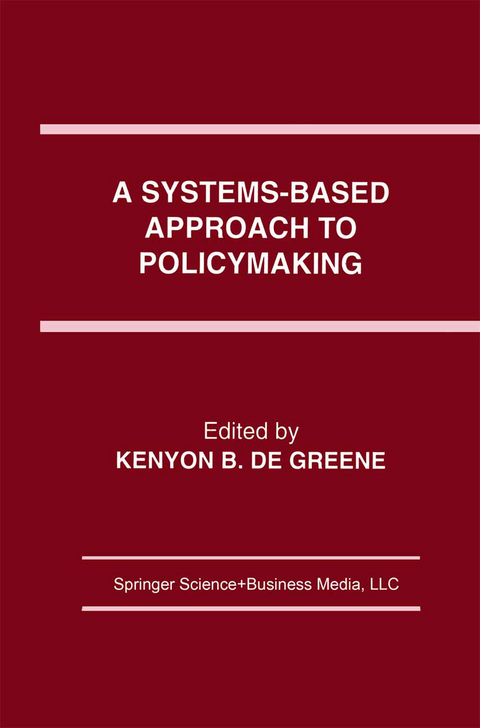
A Systems-Based Approach to Policymaking
Springer (Verlag)
978-0-7923-9336-8 (ISBN)
This book is based on a number of systems concepts, of which the following are emphasized here: oThe interacting systems of society and the environment are dynamic and evolution ary oEvolution of these systems carries them through stages of differential stability and instability, continuity and discontinuity oAssociated with evolution and instability is structural change that is essentially irre versible oThe present is a stage of world transformation that may not have been equaled for decades or even centuries oPolicies and decisions must match the times, in the present case the stage of world transformation The time 11:59:59 PM, approximately, on December 31, 2000 has an impor tant symbolic meaning. It marks the end of a minute, the end of an hour, the end of a day, the end of a year, the end of a decade, the end of a century, and the end of a millennium. The time and date provide a convenient yardstick against which we can evaluate the evolution of our thinking and the adequacy of our assumptions, mental models, paradigms, and policies. Will the beginning tum out to be appropriately dif ferent from the end? We hope that this book is helpful in such evaluation. This is a new-paradigm book, which both presents and advances the new way of thinking about the systems of science, technology, society, economics, politics, and the environment, and actively calls for the replacement of the worn out cognitive/sociotechnical paradigm.
1. Policy Challenges in a World of Nonlinearity and Structural Change.- and Main Assumptions and Problem Sets.- New Thinking for New Times.- What is Policymaking?.- Cognitive/Emotional Models of Policymakers and Decisionmakers.- A Simple Mathematical Model of Nonlinearity.- Structural Change the Kondratiev and Hegemonic Cycles/Structures and the Life Cycle of the Present Stage of World.- Civilization.- Let the Policy Fit the Time.- Conclusions and Recommendations—Policy Guidance.- References.- 2. Policy in a World of Evolution, Learning, and Ignorance.- The Mechanical and Organic Open-Systems Paradigms Further Contrasted.- Evolutionary Drive.- Applications for Policy Exploration: From Settlement To Finance.- Discussion.- References.- 3. Adaptive Control and Conflict Resolution for International Stability.- Overview of International Stability and Conflict Resolution Issues.- The Peace/War/Peace Process and Some of its Elements.- International Stability and Peace.- Nation Block Diagrams.- Peace/War/Peace Time (Activity) Cycle.- Normal, Alert, or Emergency Conditions of International Policymaking and Decision-Making.- Adaptive Control Features for International Relationships.- Basic Assumptions about the International System and Conflict.- Elements of Conflict Resolution.- Potential Areas for International Conflict.- Progress Toward International Stability and Peace.- Common Security Objectives.- Influence of the Past, Present, and Future on National Attitudes.- Decrease the Likelihood of War, Increase the Likelihood of Peace.- What is to be Done Now?.- Conclusions.- References.- 4. Field-Theoretic Framework for Systems Theory and Systems Thinking.- The Nature and History of Field Theory Applied to Nonliving and Living Systems.- Alternative or Complementary Perspectiveson.- Field Theory and on World Systems.- Synopsis and Interfacing of Current Systems Theories.- Field-Theoretic Principles.- Faith, Ideology, Science, and Religion.- The Acceptance of New Paradigms.- Guided Structural Change in the World System Field.- Final Remarks.- References.- 5. School for Rulers.- Contemplating the Taboo: Rulers Must Learn.- Premises and Thesis.- Ideological and Structural Hurdles.- Design of a School For Rulers.- Back to Reality: Practical Recommendations.- Epilogue.- References.- 6. Policy: Appearance and Reality.- Introduction: Overview of “Problems” and “Solutions”.- Concepts and Definitions of Policy.- Distinctive Problems of Policy Formulation.- A Systems-Theoretic Interpretation.- Four World Hypotheses.- Limitations of Formism and Formal Rational Models.- Policy Expertise, and Rationality Revisited.- Challenges and Recommendations.- References.- 7. System Dynamics and the Lessons of 35 Years.- Designing Managerial and Social Systems.- A New Education for Corporate and Government Leaders.- Modeling for What Purpose?.- The System Dynamics Paradigm.- Learning From Models.- A New Basis for Pre-College Education.- References.- 8. Whole-System Concepts in Societal Transformation.- Signs of A Fundamental Transformation.- Policies for Whole-System Transformation.- Concluding Observations.- References and Suggested Reading.- 9. Breaking out of the Systems Quandary.- The Systems Quandary.- Breaking Out.- Final Words.- References.- 10. Decision Management, Then and Now, 1790, 1890, and 1990: Selected Scenario Models.- Some Definitions and Limitations.- A Basic Decision-And-Command Management Model.- Two Brief Scenario Models.- Decisionmaking in the Gulf Crisis/War: Events of 1990–1991.- Significance of the Gulf Episode.- Conclusions.-References.
| Erscheint lt. Verlag | 30.4.1993 |
|---|---|
| Zusatzinfo | XIX, 355 p. |
| Verlagsort | Dordrecht |
| Sprache | englisch |
| Maße | 155 x 235 mm |
| Themenwelt | Informatik ► Grafik / Design ► Digitale Bildverarbeitung |
| Mathematik / Informatik ► Informatik ► Theorie / Studium | |
| Mathematik / Informatik ► Mathematik | |
| Sozialwissenschaften ► Politik / Verwaltung ► Staat / Verwaltung | |
| ISBN-10 | 0-7923-9336-8 / 0792393368 |
| ISBN-13 | 978-0-7923-9336-8 / 9780792393368 |
| Zustand | Neuware |
| Informationen gemäß Produktsicherheitsverordnung (GPSR) | |
| Haben Sie eine Frage zum Produkt? |
aus dem Bereich


